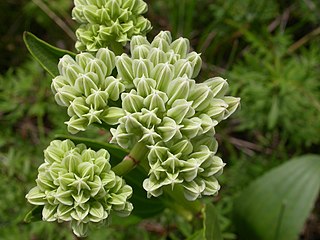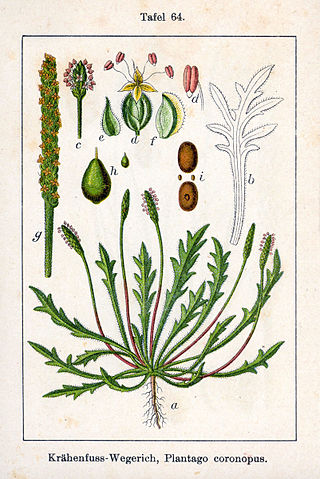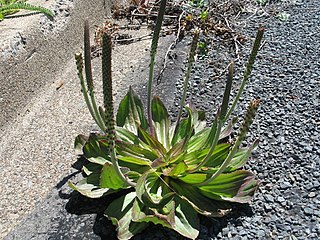
Plantago is a genus of about 200 species of flowering plants in the family Plantaginaceae, commonly called plantains or fleaworts. The common name plantain is shared with the unrelated cooking plantain. Most are herbaceous plants, though a few are subshrubs growing to 60 centimetres tall.

Alisma plantago-aquatica, also known as European water-plantain, common water-plantain or mad-dog weed, is a perennial flowering aquatic plant widespread across most of Europe and Asia, and apparently spread elsewhere in both the Old and New World.

Alisma is a genus of flowering plants in the family Alismataceae, members of which are commonly known as water-plantains. The genus consists of aquatic plants with leaves either floating or submerged, found in a variety of still water habitats around the world. The flowers are hermaphrodite, and are arranged in panicles, racemes, or umbels. Alisma flowers have six stamens, numerous free carpels in a single whorl, each with 1 ovule, and subventral styles. The fruit is an achene with a short beak.

Plantago lanceolata is a species of flowering plant in the plantain family Plantaginaceae. It is known by the common names ribwort plantain, narrowleaf plantain, English plantain, ribleaf, lamb's tongue, and buckhorn. It is a common weed on cultivated or disturbed land.

Spiranthes spiralis, commonly known as autumn lady's-tresses, is an orchid that grows in Europe and adjacent North Africa and Asia. It is a small grey-green plant. It forms a rosette of four to five pointed, sessile, ovate leaves about 3 cm (1.2 in) in length. In late summer an unbranched stem of about 10–15 cm (3.9–5.9 in) tall is produced with approximately four sheath-shaped leaves. The white flowers are about 5 mm (0.20 in) long and have a green spot on the lower lip. They are arranged in a helix around the upper half of the stalk. The species is listed in Appendix II of CITES as a species that is not currently threatened with extinction but that may become so. Autumn lady's-tresses are legally protected in Belgium and the Netherlands.

Keckiella breviflora is a species of flowering shrub in the plantain family known by the common name bush beardtongue.

Arnoglossum plantagineum also known as tuberous Indian-plantain, groovestem Indian plantain or Prairie Indian plantain, is a North American species of Arnoglossum in the sunflower family. The Latin specific epithet plantagineum refers to the leaves of the plant which are similar to those of a plantain.

Plantago coronopus, the buck's-horn plantain, is a herbaceous annual to perennial flowering plant in the family Plantaginaceae. Other common names in the US and Italy include minutina and erba stella.

Goodyera pubescens, the downy rattlesnake plantain, is one of the most common orchids native to eastern North America. It is found from Florida to Nova Scotia, west to eastern Oklahoma, Minnesota and Ontario.
Collinsia rattanii is a species of flowering plant in the plantain family known by the common name sticky blue-eyed Mary. It is native to the coniferous forests of the Pacific Northwest of the United States from Washington to northern California. It is an annual herb growing up to 40 centimeters tall with linear leaves rolled under along the edges. The leaves are hairy on the upper surface and hairless and purple-tinted underneath. The inflorescence is coated in sticky glandular hairs. It has a series of nodes from which arise one to five flowers each on pedicels. The flower is only 4 to 8 millimeters long, with two mostly white upper lobes and three mostly purple lower lobes.

Keckiella ternata is a species of flowering plant in the plantain family known by the common name scarlet keckiella.

Linaria maroccana is a species of flowering plant in the plantain family known by the common names Moroccan toadflax and annual toadflax. It is native to Morocco, but it can be found elsewhere growing wild as an introduced species, such as California. It is a readily available ornamental plant for the flower garden. This is an annual herb growing erect to approach a maximum height of 50 cm (20 in), its stem with linear leaves 2–4 cm (0.8–1.6 in) long. The inflorescence is a raceme of flowers occupying the top of the stem. At the base of each flower is a calyx with five narrow, pointed lobes. The flower is 2–4 cm (0.8–1.6 in) long with five lobes arranged into two lips with a spur at the end. The flower is often purple in color with white near the throat, but flowers of many different colors are bred for the garden. Dwarf cultivars are also available.

Plantago aristata is a species of plantain known by the common name bracted plantain or largebracted plantain. It is native to the eastern and central United States, and it can be found in other parts of North America as well as parts of Eurasia as an introduced species. It grows in many types of habitat, including disturbed areas, where it is a minor weed.

Plantago elongata is a species of plantain known by the common names prairie plantain and slender plantain.

Plantago subnuda is a species of plantain known by the common name tall coastal plantain. It is native to western North America from the west coast of the United States to west-central Mexico, where it grows in wet and moist habitat types, often in coastal areas, such as marshland. It is a perennial herb producing few oval leaves around a thick caudex. The broad smooth-edged or slightly toothed leaves may be up to 40 centimeters long. The stemlike inflorescences grow erect to a maximum height near half a meter. Atop the peduncle of the inflorescence is a dense cylindrical spike of many tiny flowers. Each flower has a corolla of ephemeral petals about 3 millimeters long.

Sagittaria sanfordii is an uncommon species of flowering plant in the water plantain family known by the common names valley arrowhead and Sanford's arrowhead. It is endemic to California, where it is known from a few scattered occurrences on the North Coast and in the Central Valley. Many occurrences previously noted in the Central Valley and in southern California have been extirpated as the plant's aquatic habitat has been lost to human activity.

Veronica copelandii is a rare species of flowering plant in the plantain family known by the common name Copeland's speedwell.

Plantago cordata is a species of flowering plant in the plantain family known by the common name heartleaf plantain. It is native to eastern North America, where it is distributed throughout eastern Canada and the eastern United States. Though it has a wide distribution, it is very localized, and populations have declined almost everywhere.

Plantago rhodosperma is a species of flowering plant in the plantain family known by the common names redseed plantain and redseed indianwheat. It is native to the Great Plains and Southwest of the United States.

Chionophila tweedyi, or Tweedy's snowlover, is a perennial herb in the plantain family. It is native to Idaho and Montana in the western United States.



















